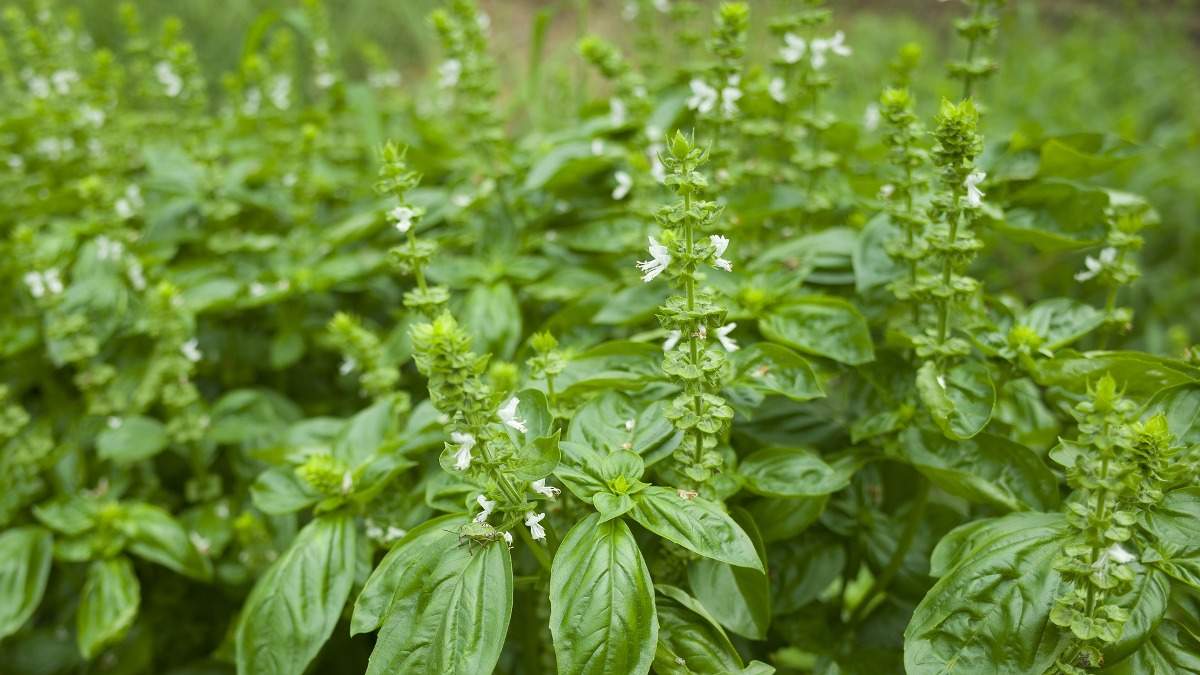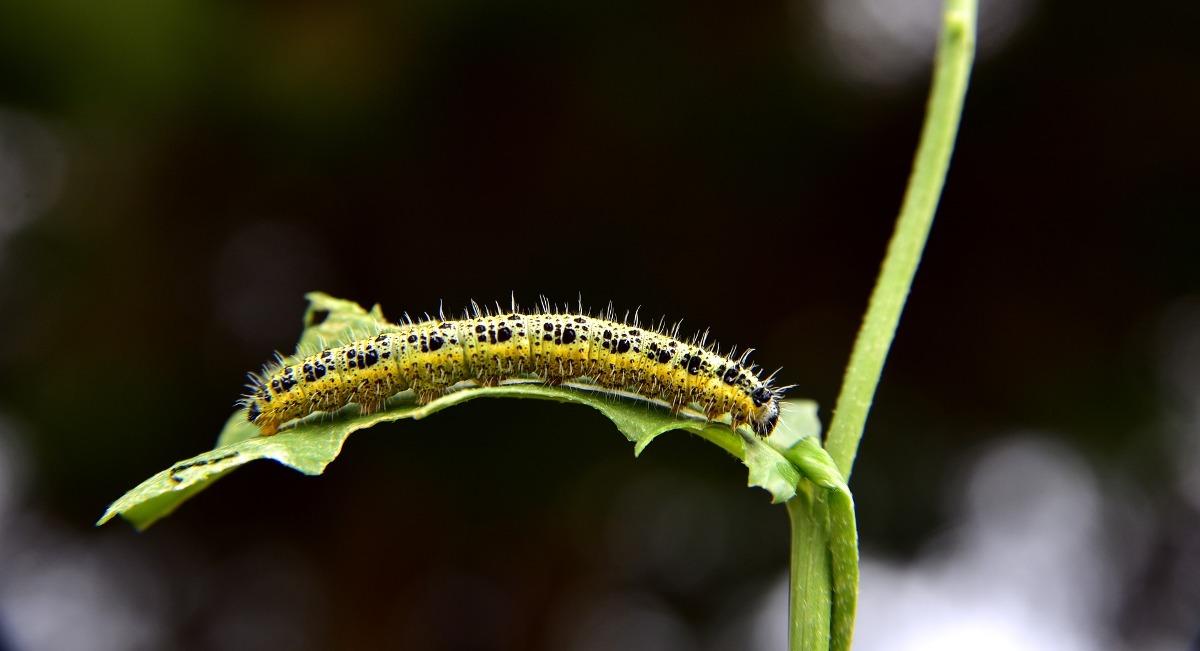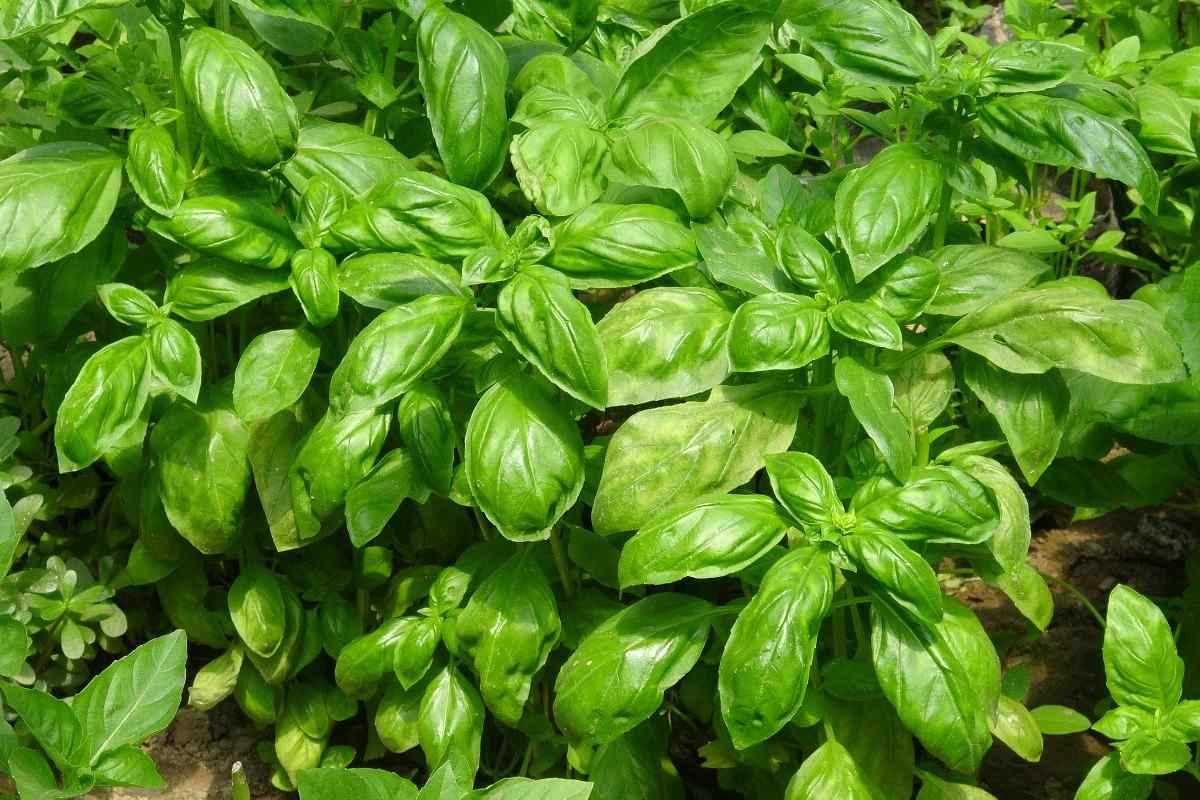Introduction to Basil pests, diseases, and control: Basil is a domestic plant and is grown widely in India. Basil is a plant of the Lamiaceae family. It is also called as Sweet Basil or Tulsi. Basil is an herb. The parts of the Basil plant that grow above the ground are used to make medicine. Many pests and diseases attacked to Basil plants. Basil plant is a popular herb prized for its flavorful foliage, mostly in cooking. Basils can be grown indoors and out in the garden and easy to look after. Though, there are several diseases in Basil plants that could cause leaf damage leading to yield losses, especially in high humidity conditions when Basils are very sensitive. Indeed, few pesticides and fungicides have been registered for use on Basil. So, learning about the common Basil diseases and preventing them from cultural practices such as maintaining good air circulation and good field sanitation coupled with using tested seeds of resistant varieties is the best method to control Basil diseases. In this article we also discuss about following topics;
- How do you keep Basil from turning brown
- How do you get rid of aphids on Basil plants
- Pest control methods in Basil plants
- Diseases affected in Basil plants
- Reasons for Basil leaves turning yellow
- Basil leaves falling off
- Basil plant care
A step by step guide to Basil pests, diseases, and their control
Basil is a short-lived annual or perennial plant in the Lamiaceae family grown for its leaves which are used as an herb. The plant grows from a thick taproot and has a silky green opposite (paired) oval leaves which grow to be 3–11 cm (1.2–4.3 in) long and 1–6 cm (0.4–2.4 in), branching out from the central stem. The Basil plant produces small white flowers that are clustered on a single spike at the top of the plant.
Growing healthy Basil

A healthy Basil plant resists pests better than a weak one. Taking great care of Basil plants is just a matter of giving it a proper location and adequate nurture. Basil plant needs a full-sun site and well-draining soil that is rich in organic matter. For best growth, Basil plant needs regular watering but avoids overhead irrigation. Basil plant works well as a container plant, so you can grow it in any region.
Pest and their control in Basil plants
Leaf rollers
Caterpillars feed themselves on plant leaves, buds, and crops. They seal the surface of plant leaves and make them roll.
To control leaf roller pest, spray with 300ml Quinalphos in 150 ltr water per acre.
You should not miss the Latest Agriculture Technologies in India.

Tulsi lacewing
Nymphs feed on leaves and leave excreta which is are not good for plant leaves. In initial stages, plant leaves get curls and then the whole plant gets dried.
To control this lacewing, spray with Azadirachtin 10,000 ppm conc.@5ml/Ltr of water.
Aphids
Aphids are a common warm weather pest. Aphids are small, generally wingless, soft-bodied insects with long antennae. Aphids mainly feed on tender new growth, causing leaf malformation and puckering; act as vectors of viruses, and generate conditions favorable to other secondary pathogens.
Prevention and Control of Aphids – Aphids can be discouraged with nearby plantings of insectary flowers in the composite and carrot family, which sustain predators of aphids. Beneficial predatory insects contain parasitic wasps, ladybugs, lacewings, praying mantids, syrphid flies, and aphid parasites. A strong jet of water can help remove aphids from the plants when numbers are not excessive. If the colony has multiplied a variety of sprays can be applied that is Johnny’s OMRI-approved controls include AzaGuard, Mycotrol, PyGanic, Safer Insect Soap, and SuffOil-X.
Whiteflies
Whiteflies are the most common pests for the greenhouse grower. There are many species of whitefly, generally identified by their 1 /16 inches long white bodies and wings. They damage the plant leaves as well as transmitting secondary diseases.
Prevention and Control – Yellow sticky cards can be used to attract whiteflies and to gauge the extent of an infestation in the greenhouse. The predatory wasp Encarsia Formosa can be released to control greenhouse whiteflies. Some sprays can be effective, such as pyrethrum, insecticidal soaps, and horticultural oils. Johnny’s OMRI approved controls consist of Azaguard, Safer Insect Soap, and SuffOil-X.
Disease and their control in Basil plants
Powdery Mildew
The fungus that produces powder on plant leaves and affects a wide range of plants. The disease is likely introduced and spread through contaminated seeds, infected leaves on the wind-dispersed spores. Moderate to warm temperatures and high humidity are favorable conditions for disease growth.
Prevention – To get rid of this disease, spray with mancozeb@4gm/ltr of water
Seedling Blight
Seedling blight is a fungal infection that causes seed or seedling to die.
Prevention – To control seedling blight, do managed phytosanitary method.
Root rot
The roots of the Basil plant get rot because of the poor drainage system. It is prevented by the managed Phytosanitary method. High humidity and poor air circulation are favorable conditions for these problems.
Prevention – Seedling blight and Root rot both are prevented by drenching the nursery beds with Bavistin @1%.
Fusarium Wilt
Fusarium wilt is one of the common diseases associated with Basil. It is a soil-based disease that can stay in the soil for several years. The first symptoms of fusarium wilt disease are yellowing shoots as well as yellow leaves that appear when the plants are 8 to 10 inches tall. In wet conditions, the plant can show white or orange fungal growth on the stems. In the late stages of the disease, the plant could develop twisted stems, and the stem tissue becomes discolored.
Control – Plants affected by Fusarium Wilt disease should be removed from the soil as soon as you spot the infection. Refrain from planting Basil for about 4 to 5 years, giving the soil time to recover. Make sure that the seeds or young plants that you purchase come from reliable stock and that they are disease-free. Diseased Basil plants in pots must be thrown away and the pots should be thoroughly disinfected.
Bacterial Leaf Spot or Basil Shoot Blight
This Basil disease is caused by bacteria called Pseudomonas cichorii. Symptoms of Basil shoot blight are black or brown spots that appear on the leaves and streaking on the stems of the plant. This disease occurs when infected soil is splashed onto the plant leaves.
Controlling Bacterial Leaf Spot
- Use disease-free, viable seed or transplants
- Ensure there is free air circulation by ensuring a wide field spacing which goes a long method to prevent plant contact with the disease.
- Do not hesitate to remove diseased plant leaves and soil surface immediately.
You may also like the Papaya Seed Germination Period, Temperature and Process.
Cultural practices to manage Basil pests and diseases
The best method to manage most pests and diseases is through cultural practices that favor overall plant and soil health, including good sanitation and crop rotation. Some elements of this approach involve the following;
- Select resistant varieties where applicable.
- Grow your crop in sanitized greenhouse conditions.
- Inspect growing areas frequently and remove and destroy any diseased plants immediately.
- Provide adequate water and good drainage.
- Drip irrigation systems and mulching minimize water loss and the spread of soil-borne diseases.
- And avoid overhead irrigation, which can facilitate the spread of disease.
- Facilitate good air movement with adequate plant spacing and fans.
- Give adequate nitrogen fertility for this leafy crop.
- Ensure ample organic matter in the soil to support overall crop health.
Management strategies for Basil diseases
In greenhouses, minimizing humidity, circulating the air, increasing space between plants, and using a drip irrigation system may also help. In the field or garden, good sanitation practices must be used to minimize inoculums levels.
Many of the same management practices apply to the other diseases of Basil. Where possible, use tested or treated seed or buy healthy transplants. Use good sanitation practices should in both garden and greenhouse sites to minimize inoculums levels. Increasing space between plants and irrigating at the base of Basil plants to avoid wetting leaves may be helpful. Where remove diseased leaves or severely infected plants to help minimize the obtainable inoculums.
Integrated pest management strategies for Basil plants
The below agricultural practices should be adopted for the management of various pests of Basil plants;
- Destruction of debris, crop residues, weeds, and alternate hosts.
- Deep summer plowing
- Frequent raking of soil beneath the crop to expose and kill the eggs, grubs, and pupa.
- Hand collection and destruction of infected plant leaves and fruits.
- Adoption of proper crop rotation in crops.
- Use of resistant and tolerant plant varieties recommended by the State Agricultural Universities of the region.
- Use well decomposed Farm Yard Manure about 8 to 10 tonnes per acre or vermicompost about 5 tons per acre treated with Trichoderma sp. and Pseudomonas sp. about 2 kg per acre as seed or nursery treatment and soil application for controlling soil-borne disease that is root rot, wilting.
- Also, apply neem cake 100 kg per acre for reducing nematode population.
Causes and prevention for the black color of Basil leaves
Causes
The causes of the Black color of Basil leaves are as follows;
Soil Care – Many variables arise whenever the soils where Basil plants are cultivated are not well taken care of. An over-fertilized soil can give rise to the blackening of plants.
Sudden wilting of leafy parts – A fungus disease is known as fusarium wilt is known through common symptoms such as the blackening and browning of leaves.
Spots and Splotches – Many a fungus disease causes the prevalence of roundish black spots along with the leaves of Basil. An example is a downy mildew in which black spots appear on the undersides of Basil leaves.
Insects – We can tag insects as agents of pollination in that they help plants reproduce them as vampires since some of their types feed off and damage plants.
Prevention
- Minimize excessive application of artificial Fertilizers.
- Fertilize soil using the natural Organic matter.
- Avoid overhead watering of plants and water at the base of the plant using the Drip irrigation type.
- Ensure proper drainage of the soil.
Causes and prevention for the brown color of Basil leaves
Causes
Pests and Diseases – Most pests insects suck up the sap of plants thereby causing the browning and curling of green foliage. Such an insect is in the form of mites, aphids, and thrips. Also, whenever leaves come in contact with a fungus disease such as Fusarium wilt (Damping-off disease) causes leaves to change color to brown.
Prevention
- Minimization in the use of Artificial Fertilizers and an increase in the use of Organic fertilizers.
- Ensure Basil receives enough water mostly from the soil.
- Ensure the Basil plants abide with the recommended spacing.
- Spray Horticultural oil when weather is cool to eradicate insect pests.
Causes and prevention for the white color of Basil leaves
Causes
Powdery Mildew – This form of mildew is quite common, and it occurs for plant types including the Basil plant.
White Insects – Colonies of white insects present on leaves usually create whitish spots on the leaves.
Prevention
- Basil plants grown together in gardens must be well spaced to ensure proper air circulation.
- Protect Basil plants by covering with a transparent white covering.
- Apply insecticides to the Basil plants to kill off white insects.
Causes and prevention for the yellow color of Basil leaves
Causes
Yellowing of leafy parts occurs as a result of Root Rot, and root rot is a fungus disease that arises and thrives due to overwatering of soil.
Many pests, when attracted to plants, feed excessively on the green foliage.
Prevention
Compliment Basil plant nutritional supplement with the occasional addition of Fertilizers (such as Nitrogen, phosphate fertilizer). Ensure plant parts receive enough sunlight for their growth.
Frequently asked questions about Basil plant cultivation, problems
In case if you miss this: Cabbage Pests and Diseases, Control Methods.

What does overwatered Basil look like?
Yellow and drooping Basil leaves are the first physical signs of an overwatered Basil plant, but the real problem is below the soil surface where roots can rot. Pluck off any yellow or brown leaves so these unproductive plant parts stop using up the plant’s energy.
How do you fix yellow leaves on Basil?
Scatter the fertilizer near Basil plants and lightly water the soil. Basil plants suffering from a potassium deficiency often develop yellow areas between the veins on the plant leaves. Boost potassium in the soil with a commercial potassium fertilizer that is muriate of potash.
Why is my Basil plant wilting?
Most wilt issues in plants occur because of improper watering. Basil plant requires evenly moist soil and quickly begins to wilt if the soil dries. Potted Basil, especially pots kept outdoors, dry more quickly and require daily watering. Too much water can cause wilt.
How long will a Basil plant live?
If Basil plants produce in a cold place, they will probably die when there are any severe temperature drops; otherwise, they can live up to a year.
What can I spray on my Basil to keep bugs away?
Commercial soap sprays can kill soft-bodied, small Basil pests for example aphids, whiteflies, and spider mites. Insecticidal soaps are obtainable in both ready-to-use spray bottles or as a concentrate.
Conclusion of Basil pests and diseases
You can use the above information controlling Basil pests and diseases in polyhouse, controlling Basil pests and diseases in a greenhouse, controlling Basil pests and diseases in a home garden, and controlling Basil pests and diseases in hydroponics. You may also check the Hydroponic Gardening.
Hello,
If you want to go into farm business, There are so many company website this days like www virtatrade com that will enable you as a beginner to raise the fund you need to start up your farm business without you seeking for a loan.
This company is where many business dealers from all over the world generate fund that backup their various businesses financially.
I used this company to backup my cocoa beans export business each time am running loss financially.
You can visit and register with the company website here www virtatrade com to raise the fund you need now to go into your farm business now.